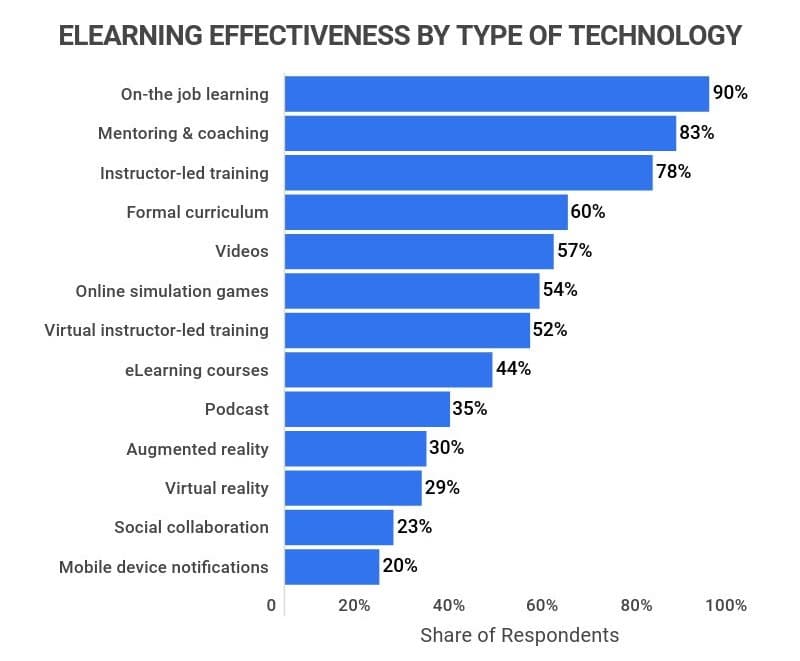- Business Statistics
- Cloud Adoption Statistics
- Customer Loyalty Statistics
- Nonprofit Statistics
- Affiliate Marketing Statistics
- Cart Abandonment Rate Statistics
- Ridesharing Statistics
- Call Center Statistics
- eLearning statistics
- Customer Service Statistics
- Customer Experience statistics
- Entrepreneur Statistics
- Outsourcing Statistics
- Gross Revenue for Marketing and Advertising
- Sales Statistics
Research Summary. Companies and schools alike have leaned more and more into eLearning over the past decade, and the trend doesn’t seem to be slowing down anytime soon. Here are some statistics about eLearning:
-
The eLearning market is projected to reach $325 billion by 2025.
-
84% of undergraduate students had at least one of their college classes move from in-person to online during the spring semester of 2020.
-
77% of U.S. companies use eLearning.
-
eLearning can help increase retention rates by 25-60%.
-
Employee training using eLearning can take 40-60% less time than traditional employee training requires.
-
The eLearning market was worth $3.5 billion in 2001 and $200 billion in 2019.
-
42% of companies experience increased revenue after implementing eLearning.
For further analysis, we broke down the data in the following ways:
Academic | Industry | Trends and Projections

Corporate eLearning Statistics
-
The global corporate eLearning industry is estimated to be worth $17.2 billion.
It’s forecast to be worth $37 billion by 2026, which would be an 11% annual growth rate.
-
44% of employees around the world believe that eLearning courses are effective.
Those surveyed employees believe this option for learning is less helpful than many in-person and some virtual settings, such as:
-
On-the-job or experiential learning (90%)
-
Mentoring or coaching (83%)
-
Classroom training (78%)
-
Formal curriculum or courses at a college or professional certification program (60%)
-
Videos (57%)
-
Online simulation games (54%)
-
Virtual instructor-led training (52%)
However, employees do believe that eLearning is more helpful than:
-
Podcasts (35%)
-
Augmented reality (30%)
-
Virtual reality (29%)
-
Learning or social collaboration apps for employees (23%)
-
Mobile device notifications or messages (20%)

-
-
41.7% of Fortune 500 companies use eLearning tools for employee training.
Companies that use this technology to train both new and current employees have seen it help to reduce distractions, use time more effectively, and increase engagement and collaboration.
-
67% of companies offer eLearning on smartphones.
Companies have begun moving away from creating training that can only be completed at a computer and toward options that use a mobile device.
As a result, the mobile learning market was projected to reach $37.6 billion in 2020.
Academic eLearning Statistics
-
As of February 2021, 64% of fourth- and eighth-grade students were enrolled in fully remote or hybrid learning options.
In May 2021, this percentage had dropped to 49%.
-
In February 2021, 82% of fourth- and eighth-graders attended schools that offered remote learning options to all of their students.
36% of their schools offered hybrid options to all students, and 49% provided every student with in-person instruction if they so chose.
-
Only 24% of teachers say that all students have access to the electronics needed to participate in eLearning.
This is based on a survey conducted in May 2020, just a few months after the beginning of the COVID-19 pandemic.
-
In the fall of 2019, before the COVID-19 pandemic had begun in the U.S., over six million undergraduate students had taken at least one distance education course.
This was about 63.7% of all undergraduate students. In the spring of 2020, 84% of undergraduate students had at least one class move online.
-
43% of college students in the U.S. say they find eLearning technology “extremely helpful.”
Many of the eLearning options they use include online lectures and textbooks that allow them to pause, rewind, and rewatch lectures and test their understanding as they work through their class materials.
| Level of Enrollment | At Least One Distance Education Courses | Exclusively Distance Education Courses | Total |
|---|---|---|---|
| Undergraduate | 3.56M | 2.45M | 6M |
| Postbaccalaureate | 300K | 1M | 1.3M |
| Level of Enrollment | At Least One Distance Education Courses | Exclusively Distance Education Courses | Total |
|---|---|---|---|
| Undergraduate | 21.50% | 14.80% | 36.30% |
| Postbaccalaureate | 9.80% | 32.60% | 42.30% |
eLearning Industry Statistics
-
In 2019, the global eLearning market was worth $200 billion.
Online eLearning was the largest segment at $100 billion. The market is expected to reach over $370 billion by 2026.
-
In 2020, 35% of global eLearning revenues were earned by North America.
The U.S. is the main player in this, while Canada did contribute some. Europe was also a large contributor, although from 2020 to 2027, it’s expected that Asian-Pacific countries will account for 26% of eLearning revenues.
-
Online learning reduces emissions and energy use by 90%.
In addition, this form of schooling also reduces gas and paper use since there are fewer cars on the road to take children and teachers to school and since more assignments are completed digitally instead of on paper.
| Type of Institution | Total of Any Distance Education Courses | Percentage of Total Courses |
|---|---|---|
| Public | 5.25M | 36.20% |
| Private Nonprofit | 1.34M | 32.30% |
| Private For-Profit | 726K | 73.30% |
eLearning Trends and Projections
-
The eLearning industry is expected to see a CAGR of over 21% from 2020 to 2027.
Experts believe this growth will be driven by technology such as virtual reality, cloud-based LMS, and artificial intelligence becoming more advanced and widely used in eLearning.
-
By 2025, the global eLearning market is expected to reach $325 billion.
In comparison, the market was worth $107 billion in 2015. That means it will have tripled in size in just ten years.
-
The self-paced eLearning market is declining by about 6% each year from 2019 to 2021.
Companies that offer class materials that customers can complete on their own schedules find that people aren’t nearly as engaged with that kind of model as with models that offer more accountability. This lack of engagement hurts the company’s bottom line, which is why this type of eLearning is in decline.
-
The eLearning industry has grown by more than 900% since 2000.
As eLearning has been widely adopted during this time, eLearning companies’ revenues have gone up simultaneously, with no sign of slowing down.
eLearning Statistics FAQ
-
Yes, eLearning is effective. 43% of college students say they find eLearning “extremely helpful,” and 44% of employees whose companies use eLearning believe that it’s effective.
Many cite the ability to complete courses on their own schedules, pause or rewatch a lecture, and test their knowledge as they go as benefits of eLearning. However, many employees still prefer on-the-job training or in-person training, and many college students do as well.
In addition, there have been an unusually high number of failing grades given to K-12 students who have been participating in eLearning, which has called its effectiveness for this age group into question.
-
What are the positive effects of online learning?
The positive effects of online learning include learning at your own pace, testing your knowledge of the material as you go, and removing social pressure from the learning environment.
These will depend on the particular eLearning program, but these are generally some of the top benefits employees and students experience. eLearners enjoy being able to squeeze in a training session in between their other daily tasks, being able to pause, rewind, or rewatch a lecture, and not having to participate in group discussions.
In addition, a benefit that companies see is being able to offer standardized training across their whole company instead of hoping that individual managers will conduct the training correctly.
-
What percentage of students are doing online learning?
64% of fourth- and eighth-grade students are enrolled in a fully remote or hybrid school program. While this is only a sample size of two grades, it’s a good example of what elementary and older middle school-aged students are doing as of February 2021.
-
How big is the eLearning market?
The eLearning market is worth $200 billion. This is the value of the global eLearning market in 2019, and it’s only continued to grow. Experts believe that it will reach $325 billion by 2020, which is more than triple the value of the market in 2015 ($107 billion).
-
What percentage of companies use eLearning?
77% of companies use eLearning. More specifically, 77% of U.S. companies used eLearning as of 2017, and it can be safely assumed that this percentage has only gone up since then.
In addition, 41.7% of Fortune 500 companies use eLearning to train their new and current employees.
Conclusion
eLearning has become an integral part of many schools and companies, from online homework assignments to virtual onboarding programs. As a result, the eLearning industry has grown by more than 900% since 2000 as technology has improved and become more readily available, and it’s expected to reach a value of $325 billion by 2025.
The COVID-19 pandemic also helped spur this growth, especially in schools, as 84% of undergraduate students said they had at least one class switch from in-person to online during the spring of 2020. In February 2021, 82% of fourth- and eighth-grade students attended schools that offered remote learning or hybrid options to every student.
While 44% of employees and 43% of college students believe eLearning is effective or “extremely helpful,” the benefits are debated for K-12 students.
This is due largely to a lack of appropriate resources to make eLearning doable: Only 24% of teachers surveyed in May 2020 could confidently say that every one of their students had access to the tablets or laptops they needed to participate in eLearning.
References
-
Statista. “Market Size of the Global Corporate e-Learning Industry in 2019 with a Forecast for 2026.” Accessed February 9, 2022.
-
Statista. “Share of Employees Worldwide Who Believe Learning Technologies Are Effective in 2018, by Type of Technology.” Accessed on February 9, 2022.
-
Skill Dynamics. “How Are Top Fortune 500 Companies Using eLearning To Boost Productivity.” Accessed on February 9, 2022.
-
eLearning Industry. “Top 20 eLearning Statistics for 2019 You Need To Know [Infographic].” Accessed on February 9, 2022.
-
NCES. “Fast Facts: Back-to-School Statistics.” Accessed on February 9, 2022.
-
The Hechinger Report. “Hundreds of Thousands of Students Still Can’t Access Online Learning.” Accessed on February 9, 2022.
-
NCES. “Fast Facts: Distance Learning.” Accessed on February 9, 2022.
-
Statista. “Size of the Global e-Learning Market in 2019 and 2026, by Segment.” Accessed on February 9, 2022.
-
Campus Technology. “E-Learning Market To Reach $1 Trillion Within 6 Years.” Accessed on February 9, 2022.
-
Triple Pundit. “4 Unsung Environmental Benefits of Online Education.” Accessed on February 9, 2022.
-
Global Market Insights. “E-Learning Market Industry Trends.” Accessed on February 9, 2022.
-
Forbes. “E Learning Climbing to $325 Billion by 2025 UF Canvas Absorb Schoology Moodle.” Accessed on February 9, 2022.
- Business Statistics
- Cloud Adoption Statistics
- Customer Loyalty Statistics
- Nonprofit Statistics
- Affiliate Marketing Statistics
- Cart Abandonment Rate Statistics
- Ridesharing Statistics
- Call Center Statistics
- eLearning statistics
- Customer Service Statistics
- Customer Experience statistics
- Entrepreneur Statistics
- Outsourcing Statistics
- Gross Revenue for Marketing and Advertising
- Sales Statistics





